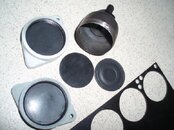My Mares regulator has just been sitting in storage for the past year. I recently took it down to Sport Chalet to have it serviced due to the annual service requirement. Usually the parts are covered but now Sport Chalet tells me that the diaphragm needed to be changed and it was $8 in parts.
Two questions:
Why did the diaphragm required to be changed when I didn't even use the thing since it's last service?
Why isn't this covered by Mares, I thought all parts as part of a regular overhaul are covered. They were the last time around I serviced it.
The "annual kits" for Mares diaphragm first stage do not contain a diaphragm or HP poppet, since these are not always changed (per the repair manual) at annual service (it is a different topic on whether they
should be).
During a full service, the 1st stage diaphragm is removed and inspected, an possibly reused, or replaced .... it is
supposed to be blown out with comressed air to prevent possible damage from attempting to pry it out (damage to both the diaphragm AND more critical the 1st stage).
I typically just replace the diaphragm (if I have a spare). Old mechanical "habbits" die hard. I don't service annually, only when "needed"; but when I
do go to the trouble of fully tearing down a first stage, I'll typically replace all of the "soft" parts... this is typical "best practice" for servicing many types of mechanical devices.... if performing a service that requires extensive disassembly, go ahead and replace the seals, o-rings, etc.
You'll get a debate on whether the diaphragm should just be replaced whenever it is removed.... it DOES take a "set" from being clamped by the retainer (see knowone's photo). Some brands specify in their repair manual that it is ALWAYS replaced after being clamped once, regardless of how long or short the time was since the last service.
Anyway, not sure what Mares parts replacement policy is... I service my own... but $8 sounds about like marked up "retail" price for a first stage diaphragm... too much for what it is, but not much e can do about that (except make your own, as knowone mentioned!).
Best wishes





